From once bustling households to dreaded torture centers and military camps, pandit properties in Kashmir have withstood time and politics. Bilal Handoo travels across Kashmir to unmask the heroes guarding their neighbours’ last standing pieces of identity against all odds
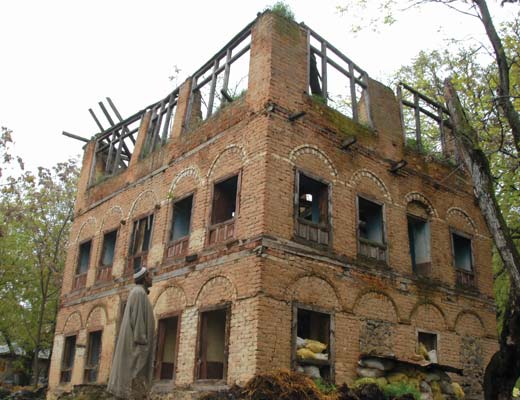
For last 17 years, Mohammad Sultan is on a ‘moral’ duty. He regularly takes walk up to the village entry point, where he stops to take a good look at something he could identify himself with. He sighs heavily before stepping back on a narrow mud path surrounded by abandoned pandit houses.
Since 1998, it is his daily routine to keep a vigil on his abandoned neighbourhood. By doing so, he hopes for a reunion with migrated pandit neighbours one day.
This is Wandhama — a disturbingly quiet village in Central Kashmir’s Ganderbal, planted with leafless walnut trees and dotted with eight deserted houses. These ruined structures give a ghostly look to this village. But a few meters walk ahead provides some respite to eyes. Some sluggish signs of life are on the roll at the backside.
“Ours was the life akin to a garden,” says Sultan, a greying man in his late forties, sitting on grocer’s shop front. “But now…” he pauses, signals toward pandit houses and then resumes, “look how our garden stands ravaged!”
He starts walking toward the abandoned pandit houses. A few of them have been razed to ground. Those standing have been rendered vacant. “Not every pandit left Wandhama during nineties,” says Sultan while passing through a ruined temple. “Many stayed put till 1998…”
That year on January 25, Wandhama was made to bleed under dark cover. It was Shab-e-Qadr and the village mosques were roaring with prayers. Inside one mosque that night, young Sultan heard some bullet shots ringing outside. He didn’t make much out of them — as such sounds weren’t unusual those days. But as barrage of bullets endlessly rang outside, he could see some person turning the mosque speakers off. He heard whispers and saw people inside getting restless.
The moment night hush resumed, Sultan stepped out of mosque only to glimpse flaming village temple. He could feel a dead silence prevailing at the entry point of village housing pandits.
Soon the night’s silence was shattered by shrieks. Villagers saw pandits dead in their kitchens, lawns, bedrooms…
This created a manic response among villagers. They abandoned their houses and sought refuge in nearby villages for days together.
With the arrival of new dawn, Wandhama was painted red. The ‘dark’ slaughter had piled up 23 pandit bodies.
Only one boy survived to detail the deadly assault.
A 14-year-old boy Vinod Dhar had given slip to killers by hiding in an attic of his house, and watched slaughter of his parents and others.
He later said that the gunmen came to their house dressed like Indian Army soldiers, who had tea with them, waiting for a radio message indicating that all pandit families in the village had been covered. After a brief conversation, pandits were rounded up and gunned down with Kalashnikov rifles, Dhar was quoted as saying.
Kashmir’s then divisional commissioner S L Bhat was quick to ‘unmask’ the killers: “This is the worst incident I have witnessed. I believe foreign militants were involved in the massacre.”
One year after Wandhama killings, Sultan says, Indian Army from nearby Mansbal Camp visited the village and took away all tin roofs from pandit houses.
“That’s why,” he says, “all these houses have been rendered roofless.” Except that ransack, he continues, Muslims of Wandhama didn’t allow anyone to fiddle with pandit properties.
But even then, many tried to make fortune out of pandit houses. Once Sultan and others sniffed the intentions, they quickly issued a press statement, saying: “None is permitted to avail pandit property at Wandhama without consulting the villagers.”
The press statement, he says, was to discourage distressing sale of pandit property spearheaded by land mafia. “This property belongs to our pandit neighbours,” says Sultan. “And we will continue to safeguard it.”
A first formal survey carried out (in 1996-97) by the State Relief Organization put the count of migrant pandit families at 25,551. While leaving Kashmir, the migrants left behind ‘bulk’ of immovable property, including 3001 structures which were alienated under the provisions of the J&K Migrant Immovable Property (Preservation, protection and restraint on distress sales) Act 1997. Besides they left 16896 kanals and 114 marlas of land.
The highest land is in south Kashmir Islamabad where 3724 kanals has been recorded and the lowest is in Bandipore with 198 kanals existed.
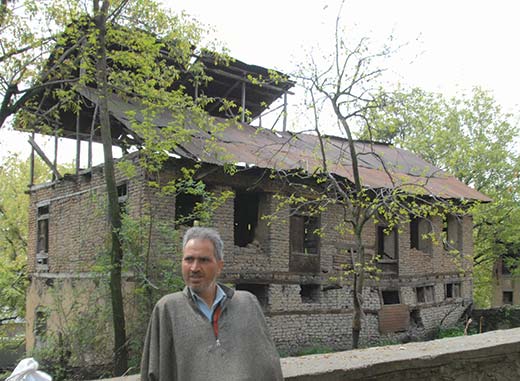
A few kilometres away from Wandhama, Nazir Ahmad Bhat makes it sure to check the condition of pandit houses facing his house on daily basis.
This is Sheikh Mohalla of Ganderbal’s Lar, where migration of pandits left behind three structures. And soon these houses became army torture centres, says Nazir, where hundreds of Muslim youth were tortured.
“Before army vacated these houses in mid-2000,” he says, “they had chopped many trees planted in their lawn and made furniture out of it before sending it to their homes across India.”
After army left, Nazir took it on himself to keep a watchful eye on these houses. “If tomorrow any of my pandit neighbours come, they wouldn’t have a reason to live in those separate townships. Their ancestral houses are safe.”
Notably, Narendra Modi-led central government has already set the ball rolling in Valley. It has directed state government to identify and earmark 16,800 kanals of land for pandit resettlement in south Kashmir’s Islamabad, north Kashmir’s Baramulla and central Kashmir’s Budgam districts.

At a short distance from Lar, there is village called Ladyun. This village still houses two pandit residential structures. A dozen of pandit families with surname Bhans used to live in them before migration. Now, these houses stare vacantly.
But this seeping absence is not discouraging someone to protect these pandit houses from becoming part of a shady deal.
Abdul Rahim, a farmer, lives closer to these pandit houses. He still remembers how during 90s Muslims used to spend nights with their pandit neighbours just to restore their confidence in the place and in the people.
“We would tell them: ‘Don’t worry. No need to panic. We are here to safeguard you.’ But then, they decided to follow their brethren,” he says.
Like other pandit houses, these two houses also served as army camps before being vacated in early 2000. And since then, Rahim has assumed a role of default guardian of these houses.
“I wish, one day,” he says, “my pandit neighbours will return to live in these houses, but I have my doubts.”
Rahim’s doubts are rooted in the fact that the migrants are entitled to various amenities under different relief categories. Basic relief including food grains, fuel and sugar is being given to all the registered families. Plus, they get monthly cash relief.
Since 1989-90, official data suggests, the government has dispensed an amount of Rs 1194.97 crore on the migrants for the cash assistance, food and other basic facilities.
“Amid these benefits,” Rahim says, “pandit homecoming doesn’t sound a reckoning move.” But politics apart, he says, “it is my moral duty to safeguard my neighbours’ properties.”
A stretch that runs through Ladyun stops at another erstwhile pandit village, Tulmulla. Some 50 to 60 pandit houses in this village are now deserted.
And to keep a close tab on these houses to prevent from getting “ransacked”, Ali Muhammad, 55, has been on toes since nineties.
“Pandits left during trying times,” he says, “but the day they will finally make their mind to return, we tell them: ‘Look, we have kept everything the way you left it.’ ”
At the moment when the ‘separate township’ for KPs is snowballing into a political crisis in valley, thousands of pandit houses remain under the protection of Kashmiri Muslims. Amid the clamour, many say: pandits must revisit their native places than to live in ‘controversial’ townships — being perceived akin to ‘Israeli settlements’ in Palestine.
After a stiff political resistance, Mufti government has set the records straight, saying: “Migrant pandits will be settled only in their native places, and not in separate colonies.” But even then, it is said, land identification has already been set in motion.
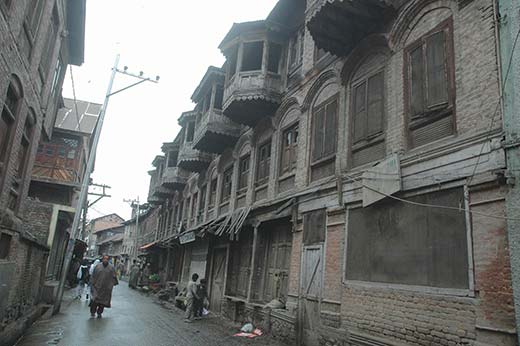
Pic: Bilal Bahadur
Quite unaware about political rhetoric, Ghulam Qadir is enjoying afternoon sun at his grocery shop. Facing dilapidated pandit houses, Qadir is the witness of a vibrant Habba Kadal that got reduced into ghost lanes in nineties after some unidentified men torched pandit houses in the area.
“After that,” he says, yawning back to normal stance, “killing of three pandits by unknown men triggered panic in Habba Kadal.”
And with that, he continues, 80 to 90 per cent houses of Habba Kadal dwelled by pandits became hauntingly silent.
The years that followed saw many pandits to sell their properties. “All these new houses you see in the area are constructed on the sold out pandit houses,” Qadir says, “While unsold pandit houses are being properly looked after by locals.”
In Bhan Mohalla of Habba Kadal, Qadir looks after many such structures whose owners — his neighbours — aren’t turning up, much to his chagrin.
At 55km from Habba Kadal, pandit houses stand ruined because of decadal abandonment. This is Kaloosa in north Kashmir’s Bandipora district that used to house nearby 60 odd pandit families till nineties. The abandoned houses were soon turned into security camp, besides torture centre.
“Now when the torture centre is no longer there,” says Shabir Ahmad, living nearby, “locals along with non-migrant pandits are safeguarding these houses.” In Kaloosa, he says, “no pandit house was ever torched.” This, he believes, must encourage government to resettle Kashmir-bound pandits at their native places.
South Kashmir’s pandit pockets are also echoing with the same voices in backdrop of ‘separate township’ row.
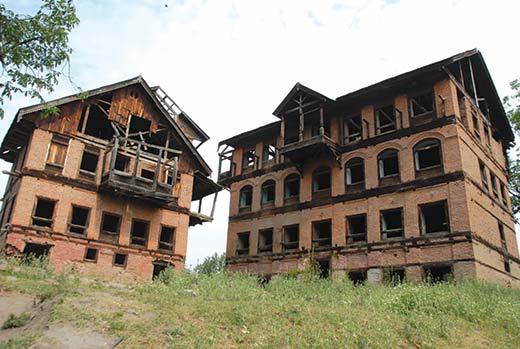
Pic: Bilal Bahadur
Haal Pulwama is a beautiful landscape dotted with equally ‘painful’ abandoned structures. Most of them have been reduced to rubble but not grabbed by illegal means. And to ensure their safety, people like Mushtaq Dar have been keeping close watch at them for last 25 years.
“We lost our neighbours in an unfortunate manner,” says Dar. “So, safeguarding their houses is our moral obligation.”
Haal used to house 80 pandit houses before migration. But now, only one pandit lives in Haal with his family.
Around 135km from summer capital, some forsaken pandit houses are on safety mode. This is Lalpora, a fringe location of Lolab. Closer to line of control, the village is surrounded by lush green forests and snow capped mountains.
In this “land of love and beauty”, ten pandit families used to live before nineties. Like their brethren, pandits of Lalpora too responded to ‘panic calls’ once armed struggle against Indian rule began in valley.
“Some of them sold their properties,” says Liyaqat Ali, a villager, “but most abandoned their immovable assets, now protected by villagers.”
In restive Sopore, scores of pandit houses are also safeguarded by Muslims. In Bomai village, there is 60-year-old man, Abdul Hameed, who keeps a close vigil at pandit properties.
“Most pandits have packed up from Bomai after selling their properties,” he says. “And whatever has been left is being looked after by villagers.”
In this picturesque village too, many are pinning hopes on pandit return to their native places. “Look,” says Hameed, “the fact is: we all are protecting our beautiful tomorrow by safeguarding these pandit structures.”
The same feelings run high in restive Palhallan town housing many pandits before migration. In Bhagat Mohalla, many pandit structures are in ruins now.
“Some houses suffered damages after army turned them into security camps,” says Zameer Mir, a local. “But the surviving structures are being safeguarded by villagers.”
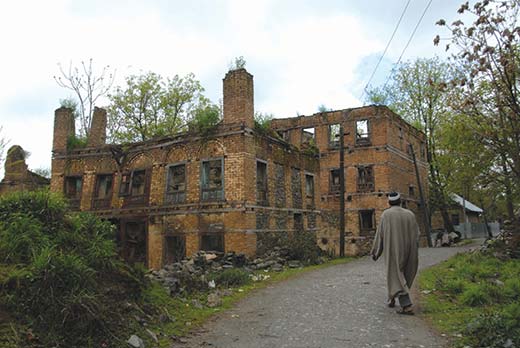
Pic: Bilal Bahadur
At Wandhama, Sultan standing near the pandit houses is getting nostalgic. He wants to relive his past. But he is quite mindful to the fact that most pandits have already burnt their returning boats.
“But those who want to return must resettle in their native houses — to recreate the beautiful past we all lost somewhere,” Sultan says before taking a walk back home amid abandoned neighbourhood.















